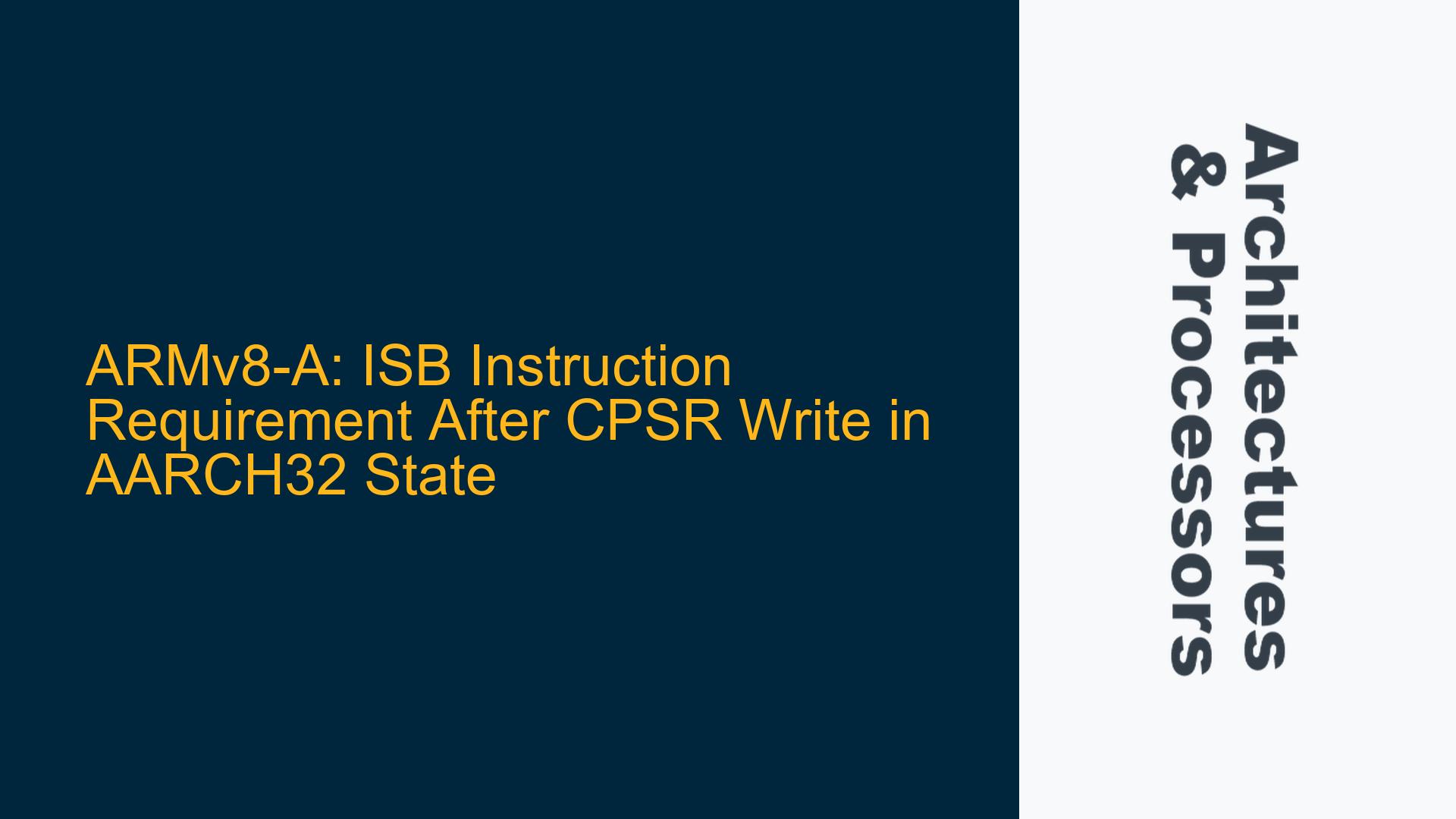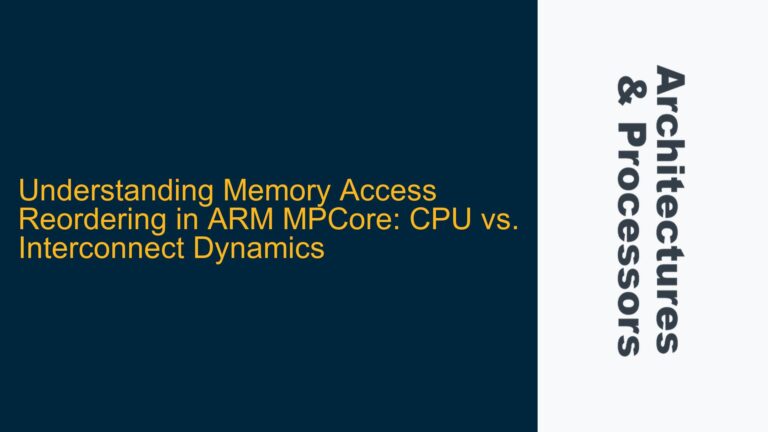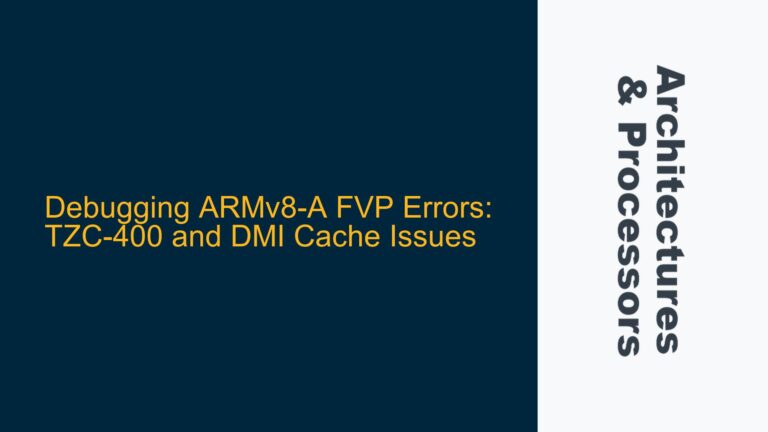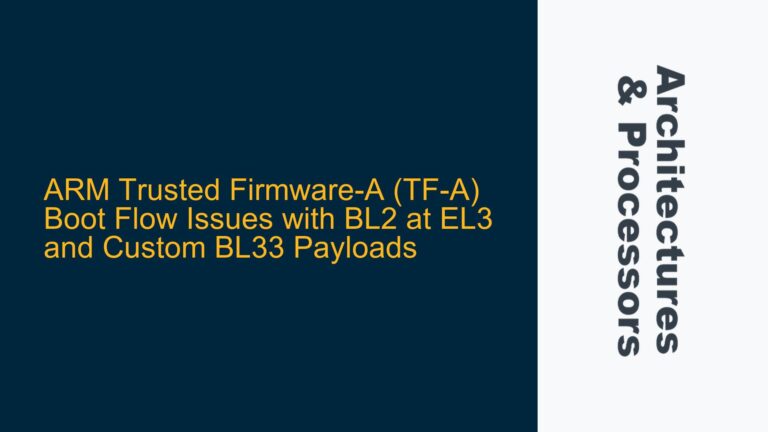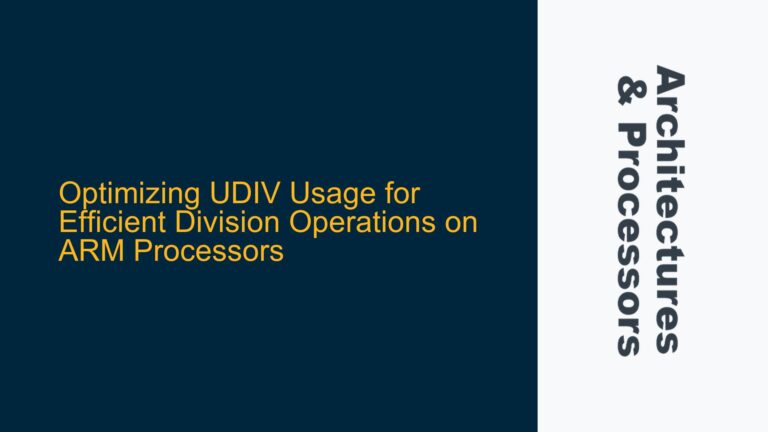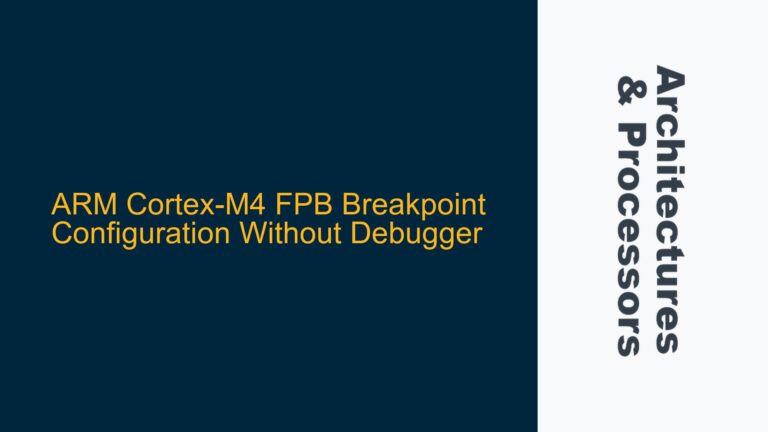ARMv8-A CPSR Write Side Effects and Instruction Synchronization
In ARMv8-A architecture, particularly when operating in AARCH32 state, writing to the Current Program Status Register (CPSR) is a critical operation that can have significant side effects on the Processor Element (PE) behavior. The CPSR register controls various aspects of the processor’s operation, including the processor mode, interrupt masks, and condition flags. When a write operation is performed on the CPSR, the changes take effect immediately, but the synchronization of these changes with subsequent instructions is not always straightforward.
The ARM architecture employs a pipeline to execute instructions, which means that multiple instructions can be in various stages of execution simultaneously. This pipelining can lead to scenarios where the effects of a CPSR write might not be immediately visible to subsequent instructions, especially if those instructions are already in the pipeline. To ensure that all side effects of the CPSR write are properly synchronized with the instruction stream, the architecture provides specific synchronization instructions, such as the Instruction Synchronization Barrier (ISB).
The ISB instruction ensures that all instructions following the ISB are fetched from the cache or memory after the ISB has been executed. This is crucial when the CPSR write affects the processor’s mode or other critical states that could alter the behavior of subsequent instructions. Without an ISB, there is a risk that instructions following the CPSR write might execute under the old state, leading to unpredictable behavior.
Memory Access Synchronization and CPSR Write Side Effects
The side effects of writing to the CPSR are generally synchronous to the write operation itself, meaning that they are guaranteed to be visible to later instructions in the execution stream. However, there is an exception to this rule: the side effects on memory accesses associated with fetching instructions. These side effects are not guaranteed to be synchronous and can lead to inconsistencies if not properly managed.
When the CPSR is written, the processor might change its mode, which could affect the memory access permissions or the address translation regime. If the processor switches to a different mode, the memory access behavior for instruction fetches might change, but this change might not be immediately visible to the instructions that are already in the pipeline. This can lead to a situation where instructions are fetched from memory using the old mode’s access permissions, even though the CPSR has been updated to reflect a new mode.
To mitigate this issue, the ARM architecture provides the ISB instruction, which ensures that all subsequent instructions are fetched under the new CPSR state. This is particularly important in scenarios where the CPSR write changes the processor mode, as it ensures that the instruction fetches are consistent with the new mode’s memory access permissions.
Implementing ISB After CPSR Write for Consistent Execution
To ensure consistent execution after a CPSR write, it is essential to implement an ISB instruction immediately following the write operation. This practice guarantees that all side effects of the CPSR write are fully synchronized with the instruction stream, preventing any potential inconsistencies that could arise from pipelining or memory access changes.
Consider the following code snippet, which writes to the CPSR and then proceeds to handle an interrupt:
mov r1, sp
movw lr, #0x393
movt lr, #0
msr cpsr_cxsf, lr
isb // Ensure synchronization
do_irq:
...
In this example, the msr cpsr_cxsf, lr instruction writes to the CPSR, potentially changing the processor mode or other critical states. The isb instruction that follows ensures that all subsequent instructions, including those in the do_irq routine, are fetched and executed under the new CPSR state. This synchronization is crucial for maintaining the integrity of the processor’s operation, especially in scenarios where the CPSR write affects memory access permissions or interrupt handling.
The ISB instruction acts as a barrier that flushes the pipeline and ensures that all instructions following the ISB are fetched under the new CPSR state. This is particularly important in real-time systems or any application where the timing and consistency of instruction execution are critical. Without the ISB, there is a risk that instructions might execute under the old CPSR state, leading to unpredictable behavior or system crashes.
In summary, when writing to the CPSR in ARMv8-A AARCH32 state, it is essential to follow the write operation with an ISB instruction to ensure that all side effects of the CPSR write are properly synchronized with the instruction stream. This practice helps maintain the consistency and reliability of the processor’s operation, especially in scenarios where the CPSR write affects critical aspects of the processor’s behavior, such as mode changes or interrupt handling.
Detailed Analysis of CPSR Write Side Effects
The CPSR in ARMv8-A architecture is a complex register that controls various aspects of the processor’s operation. Writing to the CPSR can have several side effects, including changes to the processor mode, interrupt masks, and condition flags. These side effects are generally synchronous to the write operation, meaning that they are guaranteed to be visible to later instructions in the execution stream. However, the side effects on memory accesses associated with fetching instructions are not guaranteed to be synchronous, which can lead to inconsistencies if not properly managed.
When the CPSR is written, the processor might change its mode, which could affect the memory access permissions or the address translation regime. For example, if the processor switches from User mode to Supervisor mode, the memory access permissions for instruction fetches might change. However, if the instructions following the CPSR write are already in the pipeline, they might be fetched using the old mode’s access permissions, leading to potential inconsistencies.
To understand the importance of the ISB instruction in this context, it is essential to consider the pipeline architecture of modern ARM processors. The pipeline allows multiple instructions to be in various stages of execution simultaneously, which can lead to scenarios where the effects of a CPSR write might not be immediately visible to subsequent instructions. The ISB instruction ensures that all instructions following the ISB are fetched from the cache or memory after the ISB has been executed, thus ensuring that they are executed under the new CPSR state.
Practical Implications of CPSR Write Synchronization
In practical terms, the need for an ISB instruction after a CPSR write becomes evident in scenarios where the processor mode changes or when interrupt handling is involved. Consider a scenario where the processor is running in User mode and needs to switch to Supervisor mode to handle an interrupt. The following code snippet illustrates this scenario:
mov r1, sp
movw lr, #0x393
movt lr, #0
msr cpsr_cxsf, lr // Switch to Supervisor mode
isb // Ensure synchronization
do_irq:
...
In this example, the msr cpsr_cxsf, lr instruction writes to the CPSR, switching the processor to Supervisor mode. The isb instruction that follows ensures that all subsequent instructions, including those in the do_irq routine, are fetched and executed under the new Supervisor mode. Without the ISB, there is a risk that the instructions in the do_irq routine might be fetched using the User mode’s memory access permissions, leading to potential access violations or other unpredictable behavior.
Another practical implication of CPSR write synchronization is in the context of interrupt handling. When an interrupt occurs, the processor typically switches to a privileged mode to handle the interrupt. If the CPSR write that switches the processor mode is not followed by an ISB, there is a risk that the interrupt handler might execute under the old mode’s memory access permissions, leading to potential security vulnerabilities or system crashes.
Best Practices for CPSR Write Synchronization
To ensure the consistent and reliable operation of ARMv8-A processors, it is essential to follow best practices for CPSR write synchronization. The following guidelines should be adhered to when writing to the CPSR:
-
Always Use ISB After CPSR Write: Whenever the CPSR is written, regardless of the specific changes being made, an ISB instruction should be used immediately after the write operation. This ensures that all side effects of the CPSR write are fully synchronized with the instruction stream.
-
Consider the Impact on Memory Access: When writing to the CPSR, consider the potential impact on memory access permissions and address translation. If the CPSR write changes the processor mode, ensure that the ISB instruction is used to synchronize the memory access behavior with the new mode.
-
Test and Validate in Real-World Scenarios: In real-world applications, especially those involving real-time systems or interrupt handling, it is crucial to test and validate the behavior of the system after CPSR writes. This includes verifying that the ISB instruction is correctly synchronizing the instruction stream and that no inconsistencies or access violations occur.
-
Document and Communicate Synchronization Requirements: In team environments or when developing code that will be used by others, it is important to document and communicate the need for ISB instructions after CPSR writes. This helps ensure that all team members are aware of the synchronization requirements and can implement them consistently.
By following these best practices, developers can ensure that their ARMv8-A applications operate consistently and reliably, even in complex scenarios involving CPSR writes and mode changes. The use of the ISB instruction is a critical aspect of this process, providing the necessary synchronization to maintain the integrity of the processor’s operation.
Conclusion
In ARMv8-A architecture, particularly when operating in AARCH32 state, writing to the CPSR is a critical operation that can have significant side effects on the processor’s behavior. To ensure that these side effects are properly synchronized with the instruction stream, it is essential to use an ISB instruction immediately after the CPSR write. This practice guarantees that all subsequent instructions are fetched and executed under the new CPSR state, preventing potential inconsistencies or unpredictable behavior.
The need for ISB synchronization is particularly important in scenarios involving mode changes or interrupt handling, where the memory access permissions or address translation regime might be affected by the CPSR write. By adhering to best practices and ensuring that ISB instructions are used consistently after CPSR writes, developers can maintain the integrity and reliability of their ARMv8-A applications, even in complex and real-time scenarios.
In summary, the ISB instruction is a crucial tool for ensuring the consistent and reliable operation of ARMv8-A processors, particularly when dealing with CPSR writes and their associated side effects. By understanding the importance of ISB synchronization and implementing it correctly, developers can avoid potential pitfalls and ensure that their applications operate as intended.
